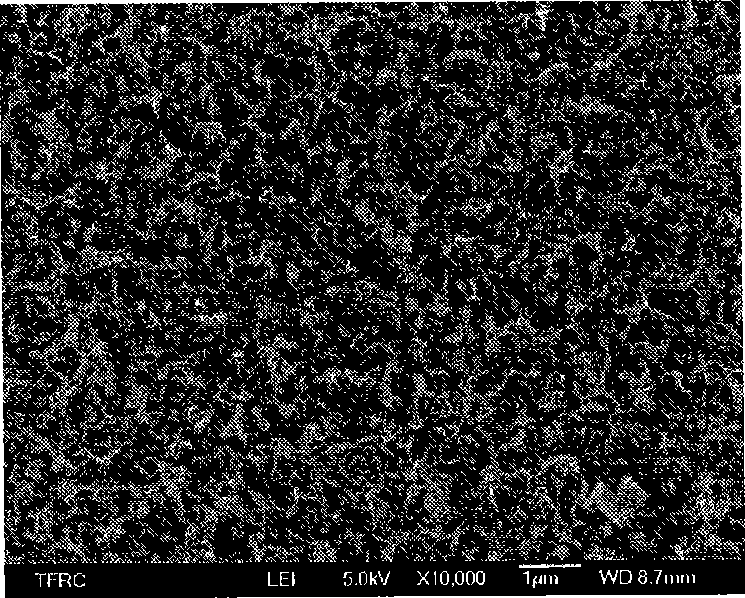Method for preparing ultra-low pressure contamination-resistance composite reverse osmosis membrane using chitosan
A technology of reverse osmosis membrane and chitosan, applied in semipermeable membrane separation, chemical instruments and methods, osmosis/dialysis water/sewage treatment, etc., can solve the problem of loss of protective layer, limited use range, operating pressure of reverse osmosis membrane low level problem
- Summary
- Abstract
- Description
- Claims
- Application Information
AI Technical Summary
Problems solved by technology
Method used
Image
Examples
Embodiment 1
[0025] Dissolve chitosan with a degree of deacetylation greater than 90% in acetic acid, stir at 50°C for 1 h, filter to remove solid impurities in the solution after standing, and configure a solution with a mass concentration of 2%; 2% glutaraldehyde solution and 1% hydrochloric acid were stirred and mixed at a molar ratio of glutaraldehyde to HCl of 1:1 to form solution B. Mix A and B solutions according to the mass ratio of chitosan and glutaraldehyde in a ratio of 4:1 for cross-linking, and then coat it on a polyamide membrane (Toray UTC-70UB) and place it at 100°C for 5 minutes The resulting membrane was preserved in 0.1% sodium bisulfite (SBS) solution.
[0026] For the performance evaluation of the reverse osmosis membrane prepared by the above method, the measured contact angle is 22°, and the water flux of the membrane is measured by using 1500ppm sodium chloride solution at 25°C, 0.75MPa, and a pH value of 7. 1.07m 3 / m 2 d, the salt cut-off rate is 99.5%, then a...
Embodiment 2
[0028] Except that maleic acid is selected as the crosslinking agent, other preparation processes are the same as in Example 1.
[0029] The measured film contact angle was 23°. The performance of the film in Example 2 was evaluated under the same conditions as in Example 1. The obtained properties are shown in Table 1 below.
Embodiment 3
[0031] Except that the mass ratio of chitosan and cross-linking agent is changed into 1:1, other conditions are identical with embodiment 1.
[0032] The measured contact angle of the film was 20°. The performance evaluation of the film of Example 3 was performed under the same conditions as in Example 1, and the results obtained are shown in Table 1.
PUM
| Property | Measurement | Unit |
|---|---|---|
| quality score | aaaaa | aaaaa |
| quality score | aaaaa | aaaaa |
Abstract
Description
Claims
Application Information
 Login to View More
Login to View More - R&D
- Intellectual Property
- Life Sciences
- Materials
- Tech Scout
- Unparalleled Data Quality
- Higher Quality Content
- 60% Fewer Hallucinations
Browse by: Latest US Patents, China's latest patents, Technical Efficacy Thesaurus, Application Domain, Technology Topic, Popular Technical Reports.
© 2025 PatSnap. All rights reserved.Legal|Privacy policy|Modern Slavery Act Transparency Statement|Sitemap|About US| Contact US: help@patsnap.com


